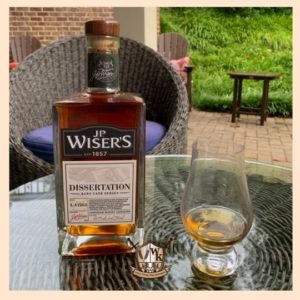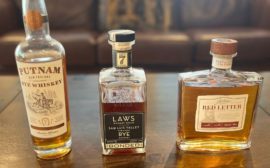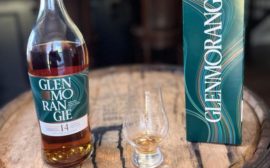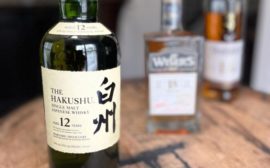Welcome to my blog, where I’ll explore the world of Canadian whisky and delve into J.P. Wiser’s. Today, I’ll review their exceptional limited release, Dissertation.
The Hiram Walker story
Hiram Walker was an American entrepreneur born in Douglas, Massachusetts, on July 4 of 1816, founder of the Hiram Walker and Sons Ltd. distillery Windsor, Ontario, Canada.
In 1838 Walker set up his grocery shop in Detroit, a booming town of 9,000 people. In 1854 Walker began selling sourced whisky from a nearby distillery and filtering it with charcoal. However, due to several government restrictive laws and prohibition sentiments in the U.S., he switched from selling whisky to selling grains, and in 1856 he started buying land across the Detroit River in Windsor, Ontario as an alternative.
The grocery business in Detroit was successful, but Walker’s passion was in distilling his whisky, not being the middleman. With that in mind, Walker used his solid grain business to sell grain to Canadian distillers, allowing him to make enough money to open his flour mill and distillery in Windsor, Ontario, where he could make and filter his whisky without restrictions.
Hiram Walker distillery started operations in 1858 and flourished due to high demand during the American Civil War (1861-1865) and the Volstead Act (1920-1933), also known as Prohibition, creating and taste for Canadian Whisky in the U.S. The distillery created a top export whisky brand (Canadian Club) and founded a small town for his workers known as Walkerville. The company subsidized rents, provided free water and electricity, funded hospitals and schools, all for the well-being of its employees.
Walker was not only an innovative distiller focused on quality but a smart businessman with political connections in the U.S. and Canada. Some of the industries he entered were: farming, oil, gas production, lumber, hotel, steamships, newspaper, and railway.
Walker was so visionary that when the Canadian government passed the Bottled in Bond Act in 1885, requiring distillers to age their whiskies for at least two years before selling them, his distillery had already established aging whisky as standard practice since 1880. Other distillers went out of business due to a significant impact of aging on their cash flows. The company is also the first Canadian distiller to blend potent flavoring whiskies with lighter corn-based whiskies and sell whisky in bottles (not by the barrels) to ensure quality to its customers.
After Walker died in 1899, the distillery passed to his three sons and later to Harrington E. Walker, the grandson, who sold it in 1926 to Harry C. Hatch. The Hatch era (1950s – 1960s) was characterized by expansion and modernization until the Hatch family sold it in 1987 to Allied Lyons, which became Allied Domecq in 1994. In 2005 Pernod Ricard bought Hiram Walker through a takeover of Allied Domecq.
Today, Corby Spirit & Wine Limited operates the distillery and owns the J.P. Wiser’s brand as the crown jewel of its portfolio.
Hiram Walker is one of the largest distilleries in North America. The distillery can produce 55 million liters per year and is famous for distilling J.P. Wiser’s, Canadian Club, Pike Creek, Gooderham & Worts, and Lot 40.
J.P. Wiser’s Dissertation Limited Release
Dr. Don Livermore is the Master Blender at Hiram Walker. The name for this whisky is the result of Livermore’s doctorate at Edinburgh’s Heriot-Watt University.
Livermore studied how wood interacted with different spirits to draw out flavors. His work produced a surplus of 60 barrels (virgin oak, first fill bourbon, re-char, etc.) that have been aging whisky for approximately 12 years (2005-2016) for this limited release whisky.
This Canadian whisky is a blend of 87% rye whisky and 13% corn whisky bottled at 46.1% ABV.
The Study
Dr. Livermore developed a technique using infrared sensors that measures the inside surface of the barrel and quantifies the wood extracts. In a matter of seconds, the sensors can determine what three years of aging in that cask will do to the spirit.
J.P. Wiser’s Tasting Notes
Nose: Complex nose, there is a hint of caramel, vanilla, and wood notes, but the rye grain is also there to greet you.
Palate: The arrival is sweet, but it does not last too long until an explosion of intense spices hits your palate. This flavor combination of wood and sharp rye spices could be overwhelming for some palates. There are also some wood tannins. By the taste, it is very likely that Lot 40 Canadian Rye is part of the recipe. A lot is going on here.
Finish: Long, waves of baking spices and oak lingering in your mouth for several seconds.
Conclusion: A unique rye-forward, robust and complex whisky. A highly recommended whisky for those who like to take a ride on the intense spicy road, the only problem is finding a bottle. This Limited Release Canadian Blend is not available in the U.S. and is very hard to find even in Canada. However, you can buy it in the UK through the whisky exchange online shop and might get it shipped to your state.
This expression won the award for Best Canadian Blend Limited Release in 2017.
You can also check other reviews and comments on my Facebook fan page. Cheers!🥃
Score: 4.25/5 ⭐
Legend
$50 or less $
$51-$100 $$
$101-$150 $$$
$151 or more $$$$






